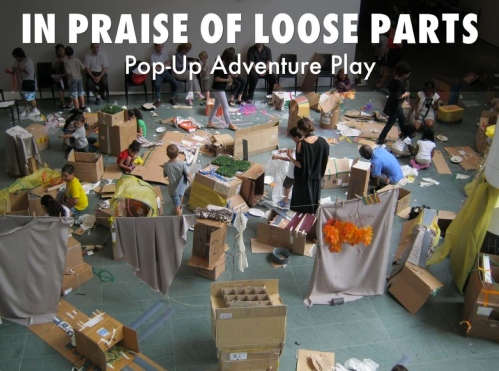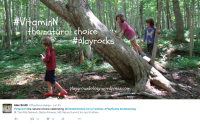Play shines a little brighter today as the Pop-Up Adventure Play team continues to shape its luminous dream. Since 2011, Morgan Leichter-Saxby and Suzanna Law have been bundling their passion, knowledge, love of kids and playwork into irresistible shared pop-up experiences in locations around the globe.
 Loose Parts Rodeo, Parish School, Houston, Texas
Loose Parts Rodeo, Parish School, Houston, Texas
The New Adventure Playground Movement: How Communities Across the USA Are Returning Risk and Freedom to Childhood chronicles their whirlwind 2014 USA tour. Ten states, a shoestring budget, 10,000 plus compact-car-fuelled miles on a coast-to-coast odyssey that – insert drum roll here please – had over 2,000 participants come out to play.
The book is a great primer for those on the lookout for affordable, alternative, community building play opportunities. I suspect Suzanna and Morgan are secretly embarked on a plot of world domination and this is their introductory manifesto. With any luck, there will be more to come.
Their point of departure is quite straightforward.
We believe that every child knows how to play, and needs only time, space, opportunity and maybe a little support in order to do so. Climbing trees, making box forts, loitering in hammocks – these are the experiences every child needs and deserves.
The reader is introduced to key people and movements that influence the authors’ outlooks on play, children and the supportive roles of adults. This includes a quick sketch on adventure playgrounds where John Bertelesen, the first staff person at the original adventure playground founded in Emdrup, Denmark in 1943, is quoted.
I consider it most important that the leader not appear too clever but that he remain at the same experimental stage as the children. In this way the initiative is left, to a great extent, with the children themselves and it is thus far easier to avoid serious intrusion into their fantasy world.
And there’s the rub, how do we as adults do our best for kids in play environments? As students of playwork (both authors are pursuing doctoral programs in the subject), supplemented with on the ground experience in a variety of settings, Suzanna and Morgan share their perspectives on this very question in a practical way. It’s about giving kids space, supporting discovery, curiosity and exploration without dominating or directing what’s going on.
 The book is full of images from their cross-country trek providing a visual inventory of loose parts materials
The book is full of images from their cross-country trek providing a visual inventory of loose parts materials
The story focuses on their visits with play enthusiasts and advocates across the USA who hosted workshops and pop-up play events and in many instances opened their homes to our erstwhile playworkers turned authors. Readers meet Jill Wood from the Parish School in Houston, Texas, Erin Marteal from Ithaca New York’s Hands-on-Nature Anarchy Zone and Craig Langlois from Pittsfield, Massachussets’ Berkshire Museum.
Left to their own devices, kids will take an unscripted, organic, meandering journey along the path of play. At pop-up play events overflowing with loose parts, there’s a natural mystic blowing through the air. The atmosphere is charged with squeals of delight and eureka moments as the creative and sometimes anarchic machinations of kids at play lets loose. This kind of play, invaluable in and of itself, has broader reverberations as the authors point out.
Children playing outside are both the symptom and catalyst of a healthy society: their presence in public space demonstrates community networks while strengthening them.
There are plenty of gems in this compact volume including fun-filled and informative photos, personal stories, useful resources, playwork principles and references. The New Adventure Playground Movement: How Communities Across the USA Are Returning Risk and Freedom to Childhood is a manual, a roadmap and a gentle manifesto all rolled into one. The book is available in many bookstores but can also be purchased directly from the authors which will provide them with a little more zip for their ongoing activities which include – surprise, surprise Pop-Ups World Tour 2015.
 Get ready it’s #PopUpsWorldTour2015
Get ready it’s #PopUpsWorldTour2015
Editor’s note – Suzanna has been very helpful to me over the years and did some excellent skype assisted hand-holding as we prepared for a loose parts event in Halifax last fall. I can attest that the Pop-Up Adventure Play course is full of excellent content and is creating a growing network of play people who are moving it for the kids. The kids had a blast at our loose parts play extravaganza and it was absolutely exhilarating for the the adults who helped pull it together.
 Click here or on this pic to link to a photo riff of the Halifax loose parts event.
Click here or on this pic to link to a photo riff of the Halifax loose parts event.
I’m forecasting intermittent, meteoric pop-up showers in the play world. This book by Morgan and Suzanna, pop-uppers extraordinaire, will be a great help to communities who want to explore the magical radiance of play.
I hope that during a future play tour Morgan and Suzanna will drop into Nova Scotia and share their spark. After all, we’re Canada’s Ocean Playground…











































